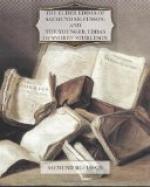one dark night, they betook themselves to flight.
No sooner had the Master missed them than he sent
in pursuit of them; but in vain, and the heavens were
too overcast to admit, according to his custom, of
reading their whereabouts in the stars. So they
traveled day and night and all the following day.
But the next night was clear, and the Master at once
read in the stars where they were, and set out after
them at full speed. Then Saemund, casting his
eyes up at the heavens, said, “Now is my Master
in chase of us, and sees where we are.”
And on John asking what was to be done, he answered:
“Take one of my shoes off, fill it with water,
and set it on my head.” John did so, and
at the same moment, the Master, looking up at the
heavens, says to his companion: “Bad news;
the stranger John has drowned my pupil; there is water
about his forehead.” And thereupon returned
home. The pair now again prosecute their journey
night and day; but, in the following night, the Master
again consults the stars, when, to his great amazement,
he sees the star of Saemund directly above his head,
and again sets off after the fugitives. Observing
this, Saemund says: “The astrologer is
again after us, and again we must look to ourselves;
take my shoe off again, and with your knife stab me
in the thigh; fill the shoe with blood, and place
it on the top of my head.” John does as
directed, and the Master, again gazing at the stars,
says: “There is blood now about the star
of Master Koll, and the stranger has for certain murdered
him,” and so returns home. The old man now
has once more recourse to his art; but on seeing Saemund’s
star shining brightly above him, he exclaimed:
“My pupil is still living; so much the better.
I have taught him more than enough; for he outdoes
me both in astrology and magic. Let them now
proceed in safety; I am unable to hinder their departure.”]
[Footnote 2: Bishop P.E. Muller supposes
the greater number of the Eddaic poems to be of the
8th century. Sagabibliothek II, p, 131.]
[Footnote 3: Codex Regius, No. 2365, 4to.
The handwriting of this MS. is supposed to be of the
beginning of the 14th century.]
[Footnote 4: Snorre, at the death of John Loptson
(A.D. 1197), does not appear to have possessed any
property whatever, though he afterwards became the
wealthiest man in Iceland. His rise in the world
was chiefly owing to his marriage with Herdisa, the
daughter of a priest called Bersi the Rich,—a
very enviable surname, which no doubt enabled the
Rev. gentleman to brave the decrees of Popes and Councils,
and take to himself a wife—who brought him
a very considerable fortune. If we may judge
from Snorre’s biography, Christianity appears
to have effected very little change in the character
of the Icelanders. We have the same turbulent
and sanguinary scenes, the same loose conduct of the
women, and perfidy, and remorseless cruelty of the
men, as in the Pagan times.]
INTRODUCTION TO THE VOLUSPA.




